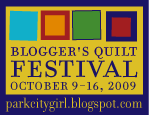Here’s a picture of a wonderful Singer sewing machine that I’ve brought out for use for a while…

I have a second hand Designer I that I bought for its embroidery ability, but now mostly use only for piecing and machine applique. I enjoy using this machine because of all its bells and whistles which enable me to sew with less physical effort – auto presser foot lift; needle up down; even auto thread cutter – all this means that my hands stay on my fabric, and my foot stays on the pedal.
Today my D1 ended up with a broken bobbin winder – first it went clunk clunk when it started winding; after pushing it back into the non-winding postion, and then again into the winding postion, the bobbin winder post and something else went clunk down into the depths of the machine. So it has to go the sewing machine doctor.
I do have a second machine – a wonderful Viking Sapphire that I bought almost two years ago – I use this for garment sewing; home dec; and most important, quilting! I like to be able to set up my quilting, then walk away, and still do some piecing without having to disturb the quilting set up.
So my husband took a Singer 411G out of the cupboard for me. We cleaned it up and oiled it. Gee, I’ve forgotten just how much I love these older mechanical machines (they aren’t really old, because its younger than me! lol). The clear view to the needle, the great straight stitch, the humm of the motor. And, its just so much more interesting to look at than the current styles of plastic sewing machines.
The little metal gadget to the right of the needle in this picture is a seam guide – place it so the short edge is up against your fabric, the required distance from the needle – tighten with the screw and voila! a pefect seam allowance.
The 411 is very similar to the Singer 401, except made in Germany instead of the States and if you have the right accessories, it can also do a chain stitch – handy for basting and decorative sewing. The 401 was the first Singer machine made specifically for home use that did more than just a straight stitch. As quilters, we’re all familiar with the Featherweight; the last straight stitch machines produced were a 201 and a 301, both full size. There is a model called a 316 and its cousin, 319, that do zig zag and other fancy stitches, but this was made with more “industrial” type use in mind, and required special needles.











1 comment:
It's a lovely little machine. I keep thinking I should use one or two of my older machines, but it usually ends up being a case of not enough space to set them up. LOL
Post a Comment